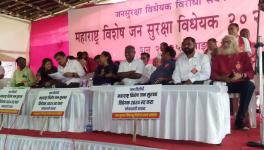National Press Day: Journalists Being Increasingly Heckled and Gagged
Representational use only.
New Delhi: Instances of intimidation and gagging of the press have been rising in India, the latest being the arrest and bail for two journalists covering Tripura violence, the prolonged incarceration of Siddique Kappan and slapping of the draconian UAPA on Shyam Singh Meera for a tweet on Tripura among others.
As India observes National Press Day, two recent reports by a rights group and an independent journalist have confirmed fears of increasing gagging of the press. The reports hold vivid accounts of detainment, arrests, and harassment of scribes by law enforcement agencies.
Released this week, India: Media’s Crackdown During Covid-19 Lockdown has surveyed instances of media personnel being booked by the police in 2020, the year of India’s first pandemic induced lockdown.
Collated and published by the Delhi-based Rights and Risk Analysis Group (RRAG), the report states that as many as 55 journalists “faced arrest, registration of FIRs, summons or show-cause notices, physical assaults, alleged destruction of properties and threats” for reporting on COVID-19 or “exercising freedom of opinion and expression during the national lockdown between March 25 and May 31, 2020,” The Wire reported, quoting a press note.
The report said that as many as 22 FIRs were filed against various journalists during the period while at least 10 were arrested “and four others were saved from being arrested by the Supreme Court for performing their duties during the period”.
Ashwini Saini, a contributor to the Dainik Jagran in Himachal Pradesh, has five FIRs against him, the RRAG report reads. The first one was registered when, on April 8, 2020, Saini made a video report on the plight of migrant workers stuck in Mandi district because of the lockdown, and the failure of the administration to provide them with rations. When the anguished scribe wrote a letter to Prime Minister Narendra Modi, the local police file three additional FIRs on him under the Disaster Management Act.
On April 13, an undeterred Saini once again made a report on brick kilns that were operating despite a strict lockdown. Then came the final FIR under the Motor Vehicles Act and his car was seized.
The pandemic period has escalated attempts at gagging the press, as established in another report by independent journalist Geeta Seshu. Titled Behind Bars: Arrest and Detention of Journalists in India 2010-20, the report analyses summons, detention, arrests, questioning and show-causes notices against scribes in the past decade.
According to The News Minute article on the same, of the 154 journalists arrested, detained, or interrogated in the decade, 40% cases were reported in 2020 alone, the year of the pandemic’s advent in the country. Foreign journalists, too, have faced challenges, with nine of them being deported or denied entry to the country.
The study also indicates a lack of proper action being taken. “Attacks on journalists, including the horrific hounding and assault on Caravan journalists Shahid Tantray, Prabhjit Singh and a woman journalist in the national capital in Delhi on August 11, continue unabated. The nexus between law-enforcing agencies, the local administration and local business and political interests have ensured that justice remains elusive,” the report reads.
Significantly, 73 of the 154 cases documented in the study in the past decade have been reported from Bharatiya Janata Party-ruled states.
The report also finds that, apart from being booked under sections of the Indian Penal Code (IPC), ‘terror’ related charges and sedition have also been increasingly used against media persons. Presently, three journalists are in custody for cases under the Unlawful Activities (Prevention) Act or UAPA, with one of them having been sentenced to life imprisonment.
Siddique Kappan’s case is a prime example of how media gagging is no longer restricted to intimidatory actions, but now involves draconian action by the state apparatus.
A journalist from Kerala, Kappan has been in jail for over a year now. He was picked up by the Uttar Pradesh police when he was travelling to visit the site of the gruesome Hathras gang rape. Kappan has been facing charges that include sedition, conspiracy to incite violence, outraging religious feelings and sundry terrorism charges.
In another recent instance of curbing the flow of information, two Delhi-based lawyers were charged with the UAPA and sections of IPC by the West Agartala police station for allegedly disseminating information on social media about the recent communal violence in Tripura. For tweeting “Tripura is burning,” Shyam Meera Singh, a journalist was booked under UAPA as well, attracting widespread condemnation from civil society.
It is no wonder then, that India’s ratings in the annual World Press Index have been continuously sliding. The 2020 index, put together by Paris-based Reporters Without Borders, has placed India in the 142nd position, below neighbours Nepal, Bhutan and Sri Lanka.
Get the latest reports & analysis with people's perspective on Protests, movements & deep analytical videos, discussions of the current affairs in your Telegram app. Subscribe to NewsClick's Telegram channel & get Real-Time updates on stories, as they get published on our website.























